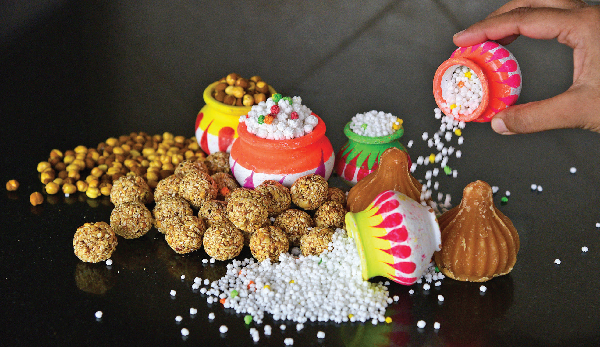Combining science and spirituality, our wise ancestors had designed the festivals, traditions and rituals so that mankind can avail maximum benefits from Mother Nature and its seasons to enjoy a healthy, joyful life and the festival of Makar Sankranti the perfect example of this phenomenon.

it's Makar Sankranti today! One of the many ancient festivals observed In India in accordance with the solar cycles, Makar Sankranti falls on the first day of Sun's transition into the Makar (Capricorn) Raashi marking the end of the month with the winter solstice and the start of the longer days. This day is celebrated to offer gratitude to Sun deity.
"Being a festival that celebrates the solar cycle, Makar Sankranti almost always falls on the same Gregorian date every year (January 14), except on rare occasions when the date shifts by a day for that year due to the complexity of earth-sun relative movement," explains Dr Pramod Pathak, a scientist associated with Goa Energy Development Agency (GEDA). Dr Pathak says, "Sun, the king of the Zodiac will be entering into the earth sign Capricorn at 13.47 pm on January 14 and in most parts of India, this occasion is celebrated joyfully."
India has a rich tradition of colourful festivals celebrated by diverse religious faiths. Makar Sankranti is one such festival that brings and binds the people following Sanatan Dharma together in this agricultural nation. Combining science and spirituality and weaving myths around them, stories are told and retold in this land of sun and sunshine so that life is lived in sync with nature and universe.
"As per Ayurveda, consuming Til-Gul (sesame and jaggery) during this time of the season is considered to be healthy as it produces heat in the body and hence the ritual of offering this to each other is followed," explains Nirmala Shirude, wife of a farmer from Jalgaon. The other foods that are eaten during this season are bajra, butter, brinjal, carrot, moong etc.
The festival is known by various names - Lohri in North India, Sukrat in Central India, Uttarayan or Utraan in Gujarat, Bhogali Bihu in Assam, Uttarayani in Uttarakhand, Pongal in Kerala, Khicadi Sankranti in Garhwal. In South India, the Tamil year begins from this date. The festival is known as Thai Pongal in South India. The manner of celebration varies in each region.
According to Hemalata Yeole from Pune, Makar Sankranti is observed consecutively for three days in Maharashtra - January 13, 14 and 15 and called Bhogi, Sankrant and Kinkrant respectively. On the day of Makar Sankranti, i.e. January 14, friends and relatives are offered Til-Gul (a sweet made of sesame and jaggery) while women are offered a gift along with the sweets. Also all are requested to exchange a sweet talk throughout the following year. The married women visit each other's homes on this day and celebrate Haldi Kumkum."
It was on this day - according to the ancient scriptures and mythological beliefs - that the Goddess Sankrantidevi killed the demon Sankarasur. The third day, Kinkrant is, however, considered to be an Ashubh or inauspicious day. It was on this day that Goddess Sankrantidevi killed the demon Kinkarasur and thus relieved the people from his oppression. However, there is no restriction on celebrating Haldi Kumkum ceremony on this day.
Mamta Bharatkinker from Chattisgarh in Madhya Pradesh explains that on the day of Makar Sankranti, after an early morning bath with ubtan (aromatic herb powder), people pay a visit to the temples and offer til laddoos as Bhog to God. "We also offer Daan to the pandits. Lord Vishnu is being offered Khichadi and laddoos along with the poor people. There is no celebration of Haldi Kumkum," shares Mamta.
"Bhogi is a day marked for consumption and indulgence in the celebration of Makar Sankranti. The homes and the surrounding vicinity is cleaned and decorated with rangoli and flowers. People are invited to have a sumptuous meal of bajra rotis sprinkled with sesame seeds, butter, brijnal bharta, chutney and khichadi (rice and daal mixed and cooked together). We wear our best clothes and jewellery," adds Manju Bais from Raipur.
Lata Naik, a teacher from Porvorim, agrees that our wise ancestors have designed the festivals in such a way as to make us live healthy lives in sync with the seasons of the nature. Every festival has a scientific concept and meaning behind its celebration, she says. "Winter brings dryness in the climate and our bodies need lubricants - hence the use of sesame, butter or ghee in sweet preparations. Also, wearing black helps absorb maximum heat from the Sun," points out Lata.
"I was gifted a black silk saree by my mother-in-law a week before Makar Sankranti and asked to wear it on the day," quips newly married Shital Yeole. In many parts of the country, women wear black on this day and the Mumbai locals are full of working women -all dressed in black, in fabric gifted to them by their mothers or mother-in-laws. "Yes, we usually keep a ready stock of black silk or cotton sarees and other ready-made clothes in December and January as the demand surges for black apparels," admits a shopkeeper from Dadar, Mumbai.
"I too love to wear black saree during Haldi Kumkum on this day though I have stopped celebrating Haldi Kumkum for the last three years after experiencing that this ritual has lost its ancient glory and is being reduced to a symbol of pomp and show where women take pride in exhibiting their wealth and jewellery rather than interacting with each other respectfully, " says Chitra Kshirsagar, a writer from Taleigao.
Anita Kavlekar, a social worker from Ponda has gone a step further and appealed to her friends, not to use plastic while celebrating Haldi Kumkum this year and instead gift a plant to each other or cloth bags instead of expensive articles. Her simple advise is, "Let's respect Mother Nature.